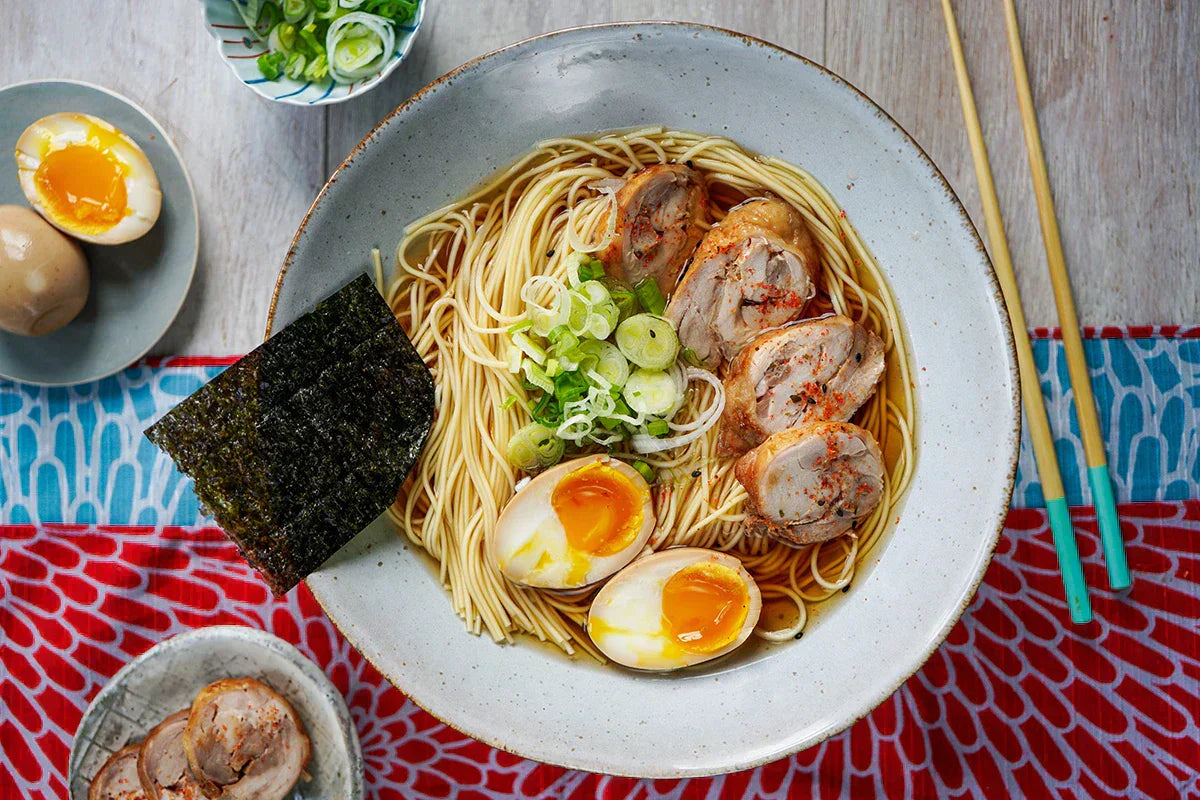
Another article from Yuki Gomi, chef, teacher and friend of The Wasabi Company, this time talking about the history and wonders of Ramen. See more from Yuki at Japanese Food. Simply. All photos by Keiko Oikawa.
Ramen’s all about its endless varieties and that rich, savoury broth that brings it all together. My favourite ramen fixes, plus a recipe for shoyu chashu chicken ramen.
Sushi, for many, is the jewel-like, flirtatious entry point into Japanese cuisine. But its culinary counterpart, ramen, is the reassuring, soulful reason to keep returning.
Ramen is a trusted dish, friendly, familiar and full of character. The distinct, punchy flavours are honed as much from regional ingredients as from the chef’s craft – it is defined more by its many varieties than by its keeping to any recipe book.
For me, a perfect, steamy bowl of ramen brings reassuring memories of the places and people I last enjoyed it with. It is a warm-hearted, adaptable rule-breaker, a dish with a cult following and many stories to tell.
Sushi and ramen both originate from Chinese dishes. Brought in off the back of trade with Japan’s near-neighbour, each was then rethought, developed and perfected, before being sent off again as quintessentially Japanese.
Throughout the Edo period, between 1603 and 1868, and into the mid-20th century, sushi was busy being served and enjoyed in high-end, Tokyo establishments – a treat, for a special occasion.
Ramen, meanwhile, was working its way up from the street – an everyday staple. Its precursor, chuka soba, aka Chinese noodle soup, really became popular during the Meiji period (1868–1912). It was a wholesome dish, the fuel of workers – noodles served in a simple, delicious (I’m sure) chicken broth.
In the late 1940s, there was an American fear that lack of food in postwar Japan would lead to political instability. It was believed that the Japanese, hungry and in despair following a rice shortage, might ally with communist neighbours in return for help. So the US began emergency food exports to Japan, in the form of wheat and lard.
These two ingredients, along with garlic, formed the basis for ramen, thereby turning the dish into a go-to “stamina food” upon which the country rebuilt itself. Ramen carries this history in each satisfying, nourishing bowl.
Ramen during the 50s and 60s was a part of Japan’s new era of experimentation and industrious acceleration on the world stage. In 1958, what is now Nissin Foods started to produce Chikin Ramen, the first dried, instant ramen variant, marketing it as a simple-to-make family food, to help families eat well at home.
The company founder, Momofuku Ando, said“Humans can’t do anything if they don’t eat. Only after their hunger has been appeased can they turn to enjoying music or art or literature”. This Pot Noodle precursor became a popular export to America and beyond in the late 1970s.

The original Chikin Ramen - Nissin Foods 1958
Dried ramen was also eaten by students and office workers away from home, as well as being a staple in emergency food packs, stored in case of an earthquake. No doubt, this all helped cultivate its status as a reassuring food, providing comfort during hard times.
Despite its humble beginnings, ramen continues to enjoy massive international recognition. In the Chef’s Table episode featuring Ivan Orkin, which also has branches in New York and across the US, the concept of shokunin – loosely defined as an artisan or craftsman – is captured perfectly. Tsuta Ramen in Tokyo, which was run by chef Yuki Onishi who sadly passed away in 2022, had a Michelin star awarded in 2016. True recognition of ramen and his soba version. He opened his first ramen restaurant with just nine seats in Tokyo’s Sugamo district. His dedication to his art was total – his mission, to devise an “only-one” ramen taste that no one can recreate. I’d love to have tried his soba ramen, there are branches of Tsuta Ramen in Singapore now. I’d love to know how it is, if you’ve been?
A shokunin will have technical skills, but it also suggests an attitude and social consciousness alongside a devotion to one’s art. It’s a spirit that gains chefs and their ramen shops cult-like status and a following of dedicated customers, keen to define themselves by their loyalty and dedication to that one best ramen spot.
Ramenistas will also have a favourite type of regional ramen. Kyushu, in the south of Japan, is home to the now-renowned tonkotsu ramen, a rich, deeply flavoured broth made from pork bones. I was lucky enough to travel there in 2019, as part of my own mini ramen tour of Japan, to try this dish in its home city of Fukuoka. The ramen in the south of Japan is generally heartier, richer and creamier – for a unique twist, a favourite was the boar broth ramen at Niimi Ramen Ibuki in Okayama prefecture.
Heading north, the broth tends to become lighter, more resembling a consommé, but the vital umami is ever present. I grew up in Tokyo and I love the regional Tokyo shoyu ramen. A broth made from chicken or pork bones is combined with classic Japanese kombu, bonito and sardine dashi to produce a super-light clear soup, full of umami flavour, topped with pork chashu and sliced bamboo shoots. If you’re in Tokyo, don’t miss Hinodeya, or for a superb, light dashi-based shoyu ramen, try Shinjiko Shijimi Chukasoba Kohaku.

Shinjiko Shijimi ramen - the flavour in the broth is from shijimi clams
from Lake Shinji in Shimane Prefacture
Other classics include kitakata ramen, and bata-kon ramen, a miso-based ramen topped with corn and butter from the northern island of Hokkaido.
With so many regional and now international varieties, the differences can be vast.
This raises the question of how exactly to define a genuine ramen. It is, in essence, the sum of four parts: a potent sauce (tare), umami-rich broth, noodles, and toppings, such as marinated eggs, spring onions, seaweed (nori) and seven spices (togarashi).
If ramen does have rules, these are the four. Oh, and Japanese like it served hot. Really hot. Like it’s been ladled from a volcano.
Rules are meant for breaking, of course, and each of these four could have its own book. A ramen chef will strive for the perfect broth, boiling bones for hours for rich flavour. Some assess the broth with a microscope to test the density of the soup base.
My grandma used to talk about which eggs had the best shells to clarify the distinctive clear broth of the shoyu ramen she would cook.
Kansui noodles are the noodles of choice for most. Alkaline, due to the bicarbonate of soda in the dough, they have a distinctive yellow colour, as well as a chewy texture that helps them hold firm in the broth without disintegrating. Each of these component parts will have been studied and laboured over by the ramen chef.
In the UK, if you’re looking for top ramen, London’s Ippudo does a delicious tonkotsu.
So how does the story of ramen continue? Vegan ramen is becoming ever more popular and can be a rich, umami-filled treat. I make mine with an umami-rich cauliflower-based topping.
Ramen is a simple pleasure to cook at home, microscope not mandatory – unless this signals the start of your own shokunin journey.

A bowl of ramen from my 3 Flavours of Ramen class - taught
in person here in south-east London
I teach shoyu, miso and tan-tan ramen in my Japanese Cooking Classes here in south-east London, alongside online shoyu and vegan versions too.
Here is my recipe for Shoyu Chashu Chicken Ramen, an ideal recipe to start with. It will not take hours to cook, but it’s a tasty Tokyo-style ramen full of umami. A nourishing, reassuring treat – or stamina food – for you to enjoy at home.
This article was originally published on Japanese Food. Simply. by chef and teacher Yuki Gomi.
Yuki blends traditional and modern techniques to make Japanese cooking approachable and delicious.
Buy one of our DIY Sushi Kits and receive a voucher for 50% OFF one of Yuki’s great courses in Japanese cooking.


